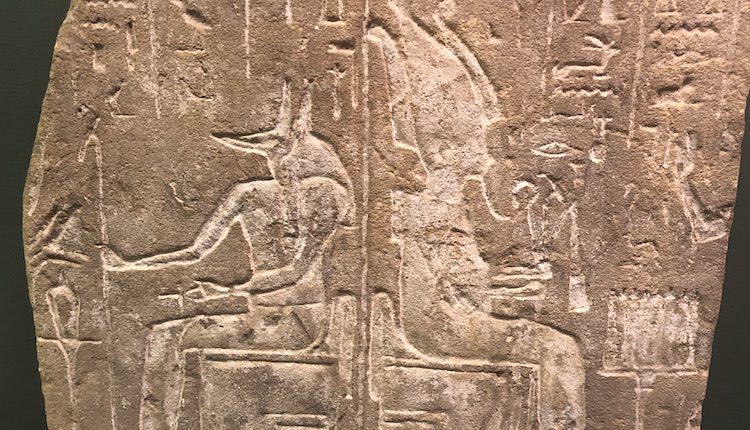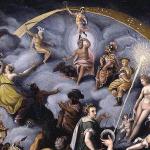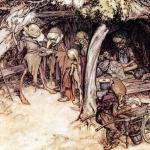My first encounter with Anubis as Master Healer was during a meditation. I found myself standing in a dark torch-lit room made of smooth stone that reminded me of the inner chambers of a temple. His presence was strong, but not intimidating. He, the Liminal Lord, stood before me, silent, but I knew that I was meant to follow him. He led me down a winding staircase that seemed to continue to go downward for ages. Downward and downward we spiraled, all the while I wondered where we were headed.
When we finally reached the bottom of the staircase, we stopped at a door. The door was a large door, made of wood and rounded at the top. Finally turning to me, Anubis smiled gently and spoke to me – not directly, but more a quiet whisper in the back of my mind. “This is the door that leads to a journey of healing. The path is dark, cold, overgrown, and frightening at times, but I promise you that, if you are willing to put forth the work needed, you will come out on the other side stronger, wiser, and more balanced.”
—

The holiday season, and really all of winter, is a busy time of the year. While bears are not-so-busily hibernating for the majority of the duration of winter, many of us humans are busy running around. With so many cultural and religious holidays sprinkled throughout the season, we we find ourselves running around with family gatherings, traditions, public and private events, dinners, parties, and celebrations. It’s a time of the year that, for many people, brings that warm, fuzzy feeling often brought about by memories and the enjoyment of all of these things.
That doesn’t mean that the season is without its stresses, and for some, even sadness or dread. Planning and executing everything that goes on takes a lot of time, effort, and preparation. For some, the loss of a loved one can lead the holidays to feelings of sadness and depression. It’s really a complex time of year, but also a good time to do some reflection and inner work.
In parts of the Northern Hemisphere, winter shows itself as a pristine, delicate beauty, with snow covered landscapes as the image in many people’s minds. Hidden just beneath this ‘winter wonderland’, the world may seem to be a cold, harsh, unforgiving dark place during the dark part of the year. Mirrored to that, symbolically, this time of year, while often full of beauty, is also a good time for reflection, for delving into the deepest and darkest parts of ourselves to reflect and to heal.
I should pause here for a moment to explain what I mean by darkness. I do not, in any way, mean to indicate that darkness is associated with the concept of “evil”. The darkness, or sometimes called our ‘shadow’ self, can include all of the old hurts, the wounds and scars, the fears, the worries, doubts, anxieties, and the parts of us we try to hide from the world…these are all a natural part of us.
This is our darkness. These are the things that can possibly hinder our growth, but when dealt with properly, can be incredibly transformational and empowering. It’s completely natural to feel these feelings, and despite what some belief systems may push for, it’s actually not a bad thing to let yourself feel them. As ugly and painful as that may sound, it’s also can be a powerful tool for healing.
I’m sure you’re wondering by now what all of this has to do with Anubis, as the title and opening might suggest he plays a part in this article. In my last article, Anubis, God of the Modern Age, I briefly mentioned that one of Anubis’ spheres of influence deals with healing.
Medicine was not an unknown concept to the ancient Egyptians, nor was it necessarily far off from many practices still existing today. Modern archeologists have found mummies with extensive dental work, amputations, and surgeries that appear to have been performed and healed long before their deaths. Surgical tools were used that are still in use today in modern medicine, as well as prosthetic limbs, often made of wood.
As Master Healer and Chief Embalmer, Anubis, and likewise his priests, would have needed an extensive knowledge of human anatomy as well as animal, as cats, dogs, cattle, and other animals were often mummified, too. Embalming and mummification would have required a knowledge of the various parts of the human body, including where various organs are located, so that they can be properly preserved. It also required a knowledge of which materials (herbs and/or minerals) work with the tissues and organs in the body in the preservation process. Because of this, is said that his priests were also well versed in herbalism and herbal healing.
Anubis’ role in healing goes beyond the physical realm, however. He’s also been referred to as the Master Shaman. The way that many pagans look at death is not necessarily literal. Life can be full of chaos, the upheavals, and change. But from that, these ‘deaths’ can be transformational. From these things, life can become something better, or at least something that we needed at that particular time.
In my own life, I have had plenty of chaotic ups and downs that needed balancing and healing, and while I can’t rightly say that Anubis can take all of the credit for this, I can say, without a doubt, he did have a large impact on my own journey through the darkness. Everything about Anubis revolves around the theme of death, even in his appearance. Many modern portrayals of him show him with contrasting black and gold colors, symbolically representing the light within the darkness – a fitting image of a liminal deity. He can stand within the darkness and still be holding onto the light.

There are many paths to healing your inner pains, and none of them are necessarily better than the other. There have been countless books, articles, talks, videos, and blog posts written about healing. It may a fair amount of time, guidance, effort, and a bit of trial and error to find what works best for you. What works for one person does not necessarily work for others.
Be patient with yourself as you work to discover your methods. Give it serious effort, but don’t push yourself, and certainly don’t get discouraged if something does not work well for you. That’s all part of the process. For me, personally, it has been a holistic approach, tackling it from a professional and spiritual vantage point.
Anubis has a funny way of showing up when people need him, often in the most chaotic and difficult periods in life. That doesn’t mean you can’t reach out to him first, though. From my own personal experiences (my UPG – refer to my previous article “Anubis, God of the Moderen Age” for a brief description of what I mean by that), Anubis is very receptive to listening to those who call to him, and he is often responsive.
“Anubis, Sovereign of Death,
Master Healer and Lord of Night,
Take my hand and guide me through the darkness
With your eyes that pierce the blackness.
Though afraid, I walk by your side
To face my shadow
To find balance
To empower.
Death, I am transformed.”
Anubis may be silent to let your discover things for yourself. But if he chooses to respond, it may not be immediately recognizable. For me, it’s rarely a ‘vision’, though sometimes a voice when my mind is quieted. People are receptive to messages in different ways. A dream, a relevant song that pops in your head, signs in nature, seeing repetitive words or numbers – these are all some, though not the only, ways that you may receive messages from Anubis.
This winter, while you are busy spending time with your loved ones, take some time for reflection. The Liminal Lord stands just beyond the shadows, his golden light illuminating the path.
References
References:
J. Hill. “Anubis.” Ancient Egypt Online. https://www.ancientegyptonline.co.uk/anubis.html. 2016.
Joshua J. Mark. “Egyptian Medicine.” Ancient History Encyclopedia. https://www.ancient.eu/Egyptian_Medicine/. 17 February 2017.


















